How is made Garden Terracotta?
This section briefly describes the current techniques used for the
production of large garden terracotta and will try to highlight the pros
and cons. This overview does not cover the techniques that are used to
produce other types of clay products, such terracotta bricks or tiles.
We must not forget that the quality of the terracotta also depends on other
factors, such as the clay used and the firing cycle. Using the Colombino
technique for working with poor quality clay or to fire the pottery with a
bad firing cycle, produces a good pot from aesthetic point of view but not
too good for mechanical strength and frost resistance.
Marrangoni Pottery
knows the right balance for making items that are excellent in terms of
quality/price and meeting the needs of the market with top quality pottery
at reasonable prices.
Colombino
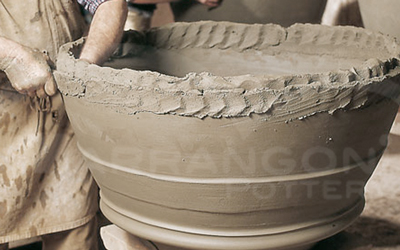 With this technique the pot is made completely by hand, without the use of
gypsum molds. First, you have to start with a base of a certain desired thickness.
After that, some colombini are made with clay (elongated cylindrical
shapes, similar to salami) and are laid one above the other starting from
the base, to make the wall of the pot. The skill of the craftsman makes the
production of the pottery of the right thickness and decorations possible
and therefore any shape is possible. Using this technique requires, in
addition to the skillfulness of the potter, a considerable amount of time
to make the pot and the technique was therefore overcome by the use of
gypsum molds.
However, it is still used today to create large and unique pieces. We can
recognize the vases made using the traditional colombino method by the typical
fingerprints of the craftsman on the inside of the pot, since the outside
is carefully finished, the inside is often left rough to save on production
time.
With this technique the pot is made completely by hand, without the use of
gypsum molds. First, you have to start with a base of a certain desired thickness.
After that, some colombini are made with clay (elongated cylindrical
shapes, similar to salami) and are laid one above the other starting from
the base, to make the wall of the pot. The skill of the craftsman makes the
production of the pottery of the right thickness and decorations possible
and therefore any shape is possible. Using this technique requires, in
addition to the skillfulness of the potter, a considerable amount of time
to make the pot and the technique was therefore overcome by the use of
gypsum molds.
However, it is still used today to create large and unique pieces. We can
recognize the vases made using the traditional colombino method by the typical
fingerprints of the craftsman on the inside of the pot, since the outside
is carefully finished, the inside is often left rough to save on production
time.
One of the distinctive features of the pots made with colombino, is
that it is highly unlikely to have perfectly identical copies as each piece
is unique.
Today this technique is used with the best quality clay and is for high-end
customers who want to have a unique piece of Tuscan handcrafted terracotta in
their space.
Pros
- Can create pots of any shape and size
- Each piece is unique and therefore more valuable
- High aesthetic quality
- Maximum customization
Cons
- Expensive
- Production time is very long
HANDMADE GYPSUM MOLD CAST
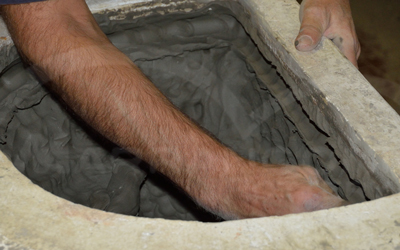 You must first create models or gypsum molds with which to cast the clay.
Each mold is the negative imprint of the pot that we will produce and must
be made with the utmost care. Each mold can be used to produce many
hundreds of pots, after which the gypsum mold undergoes abrasion and the
decorations will begin to dissapear. Therefore the molds are replaced
periodically.
You must first create models or gypsum molds with which to cast the clay.
Each mold is the negative imprint of the pot that we will produce and must
be made with the utmost care. Each mold can be used to produce many
hundreds of pots, after which the gypsum mold undergoes abrasion and the
decorations will begin to dissapear. Therefore the molds are replaced
periodically.
The craftsman uses their hands and special tools to press the
clay into the mold and to finish the inner part of the pot. Then you need
to wait for the mold to absorb the water contained in the clay to allow the
pot to contract and to become separated from the mold. At this point, the
pots are finished apart from minor details on the exterior decorations.
Unlike the colombino, this technique uses gypsum molds, and therefore the
pieces produced are more or less identical.
Pros
- Can create pots of any shape and size, even large
- Good for mass production of identical pots
- High aesthetic quality
- Ability to customize
Cons
- price is preceived as too high, but the quality/price ratio is absolutely excellent
- Production is time consuming but with more molds you can produce multiple pots at the same time
LATHE GYPSUM MOLD CAST
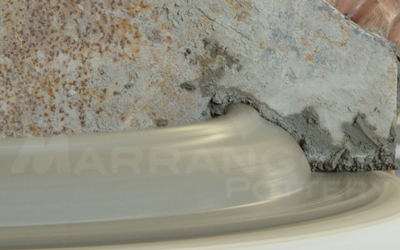 This technique can only be used on round pots and uses a machine able to
create the internal shape. The machine is a lathe, the mold is positioned
on the rotating base and using a special tool the operator can shape the
inside of the pot. The clay is put into the spinning mold without
particular attention to the consistency and then the turning of the lathe
will produces shape of the pot with the right thickness. Then the mold must
be allowed to absorb the water contained in the clay before it can be
removed. Finally, the exterior decoration of the pot is hand finished.
This technique can only be used on round pots and uses a machine able to
create the internal shape. The machine is a lathe, the mold is positioned
on the rotating base and using a special tool the operator can shape the
inside of the pot. The clay is put into the spinning mold without
particular attention to the consistency and then the turning of the lathe
will produces shape of the pot with the right thickness. Then the mold must
be allowed to absorb the water contained in the clay before it can be
removed. Finally, the exterior decoration of the pot is hand finished.
Unlike the handmade gypsum mold technique, for pots casted with the lathe
can only be made in round shapes.
Pros
- Can create pots of any size, even large
- Suitable for large production
- Pots are perfectly round
- High aesthetic quality
- Ability to personalize the pots
- relatively short production time
Cons
- Only able to make round shape
Press Machined with Gypsum Molds
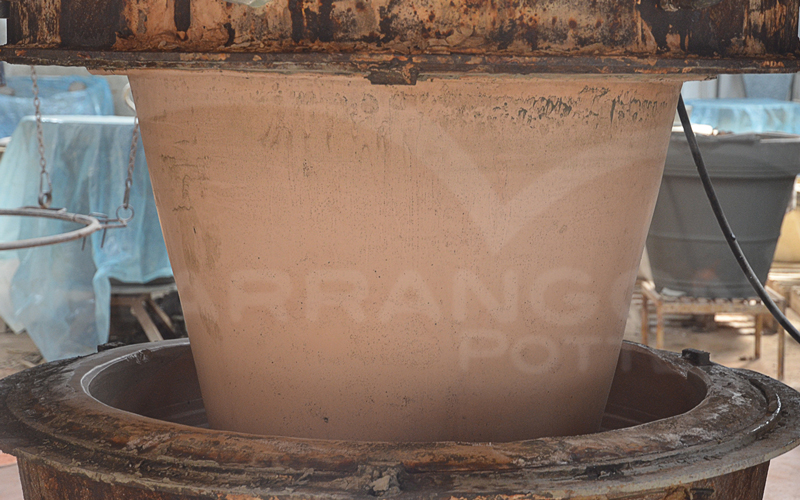 With this technique, it is very easy to create pots. Generally the machines
are full or semi automatic and you simply need to enter the clay into the
mold and the machine performs the cast and mold release immediately the
pot. The only manual step is the finishing that must be performed by hand.
With this technique, it is very easy to create pots. Generally the machines
are full or semi automatic and you simply need to enter the clay into the
mold and the machine performs the cast and mold release immediately the
pot. The only manual step is the finishing that must be performed by hand.
Pots can be made in many shapes, both round and square, with or without
decorations. The pot is detached from the cast by using compressed air. At
this point the pot is very similar to pots that have been handcrafted
concerning properties such as frost resistance.
Pros
- competitive price
- Suitable for large production
- Increased production speed
- Good aesthetic quality, as the finish is done by hand
- lack of customization
- Equal frost resistance to the handmade pots
cons
- It is not possible to create all shapes, which can be made by hand
- Final product is imperfect, the rim can be irregular
Press Machined with Metal Molds: industrial production
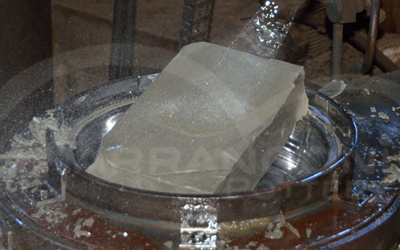 This production process is similar to that described previously with the
difference that the molds are made of metal. In order to detach the pot
from the metal mold it is necessary to use a very dense clay and an
oily release agent is sprayed on the metal mold before pressing.
This production process is similar to that described previously with the
difference that the molds are made of metal. In order to detach the pot
from the metal mold it is necessary to use a very dense clay and an
oily release agent is sprayed on the metal mold before pressing.
These two elements, the
dense clay and the oil, mix during the construction of the pot and are the
main reasons for the poor quality product and its lack of resistance to
frost. The result is that often, in the early years, you can see the
classic flaking and exfoliation of the pot.
Pros
- Very competitive price
- Suitable for mass production
- Increased production speed
- Perfect finish of the pots, typical of machine made pots
Cons
- Poor resistance to frost
- The shapes are simple
- Designed typically low key
- No personalization possibilities
